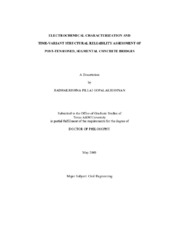| dc.description.abstract | In post-tensioned (PT) bridges, prestressing steel tendons are the major load carrying
components. These tendons consist of strands, ducts, and cementitious grout that fill the
interstitial space between the strands and ducts. However, inspections on PT bridges
have reported the presence of voids, moisture, and chlorides inside grouted ducts as the
major cause of accelerated corrosion of strands. Corrosion of the strands has resulted in
PT bridge failures in Europe and tendon failures in the United States. As most of the PT
bridges have high importance measures and the consequences of failure are significant, it
is important to maintain high levels of safety and serviceability for these bridges. To
meet this goal, bridge management authorities are in dire need of tools to quantify the
long-term performance of these bridges. Time-variant structural reliability models can
be useful tools to quantify the long-term performance of PT bridges.
This doctoral dissertation presents the following results obtained from a
comprehensive experimental and analytical program on the performance of PT bridges.
1) Electrochemical characteristics of PT systems
2) Probabilistic models for tension capacity of PT strands and wires
exposed to various void and environmental conditions
3) Time-variant structural reliability models (based on bending moment
and stress limit states) for PT bridges
4) Time-variant strength and service reliabilities of a typical PT bridge
experiencing HS20 and HL93 loading conditions and different
exposure conditions for a period of 75 years
The experimental program included exposure of strand specimens to wet-dry and
continuous-atmospheric conditions. These strand specimens were fabricated to mimic
void and/or grout-air-strand (GAS) conditions inside the tendons. It was found that the
GAS interface plays a major role in strand corrosion. The GAS interfaces that are
typically located in the anchorage zones of harped PT girders or vertical PT columns can
cause aggressive strand corrosion. At these locations, if voids are present and the
environment is relatively dry, then limited corrosion of the strands occurs. However, if
the presence of high relative humidity or uncontaminated and chloride-contaminated
water exists at these interfaces, then corrosion activity can be high. The strands were
exposed for a period of 12, 16, and 21 months, after which the remaining tension
capacity was determined.
The analytical program included the development of probabilistic strand capacity
models (based on the experimental data) and the structural reliability models. The timevariant
tension capacity predicted using the developed probabilistic models were
reasonably consistent with the tendon failures observed in PT bridges in Florida and
Virginia. The strength reliability model was developed based on the moment capacity
and demand at midspan. Service reliability model was developed based on the allowable
and applied stresses at midspan. Using these models, the time-variant strength and
service reliabilities of a typical PT bridge were determined based on a set of pre-defined
constant and random parameters representing void, material, exposure, prestress,
structural loading, and other conditions. The strength and service reliabilities of PT
bridges exposed to aggressive environmental conditions can drop below the
recommended values at relatively young ages. In addition, under similar conditions the
service reliability drops at a faster rate than the strength reliability. | en |


